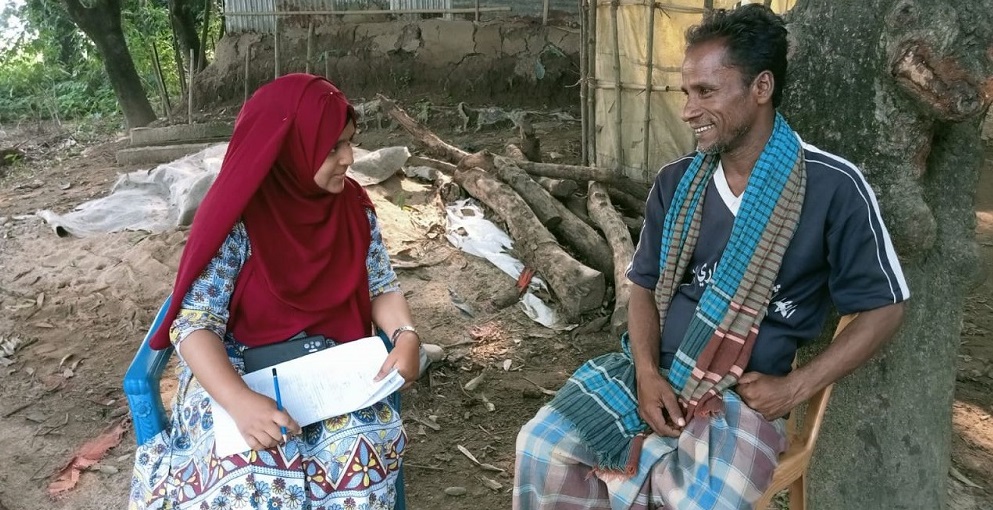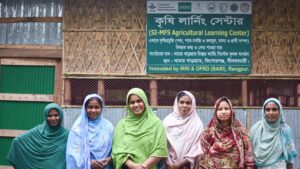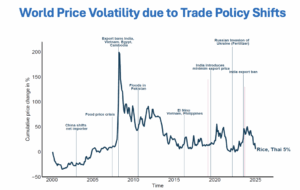by Muhammad Ashraful Habib, Tahmina Nahar, Swati Nayak, Subhasmita Mohapatra, and Saidul Islam
The Haor Region has been experiencing early-season flash floods almost every year. The flash floods completely inundate rice fields immediately before rice harvesting causing massive losses to farmers and posing threats to the food security and livelihood of the people. BRRI dhan-96 has brought about a transformation in the lives of the Haor farmers. It not only provided them with a sustainable solution to the challenges they faced but also empowered them to escape poverty. With increased productivity, they were able to realize higher incomes, improve their standard of living, and invest in their children’s education.

The Haor Region, characterized by marshy lands that remain flooded during the monsoons, has unique advantages. The soils are rich and fertile because of the organic and mineral deposits from rivers and streams brought in by flood waters. But, compared to other regions, the Haor Basin has lagged in terms of economic development.
Given the share of area and population that live in the Haor Region, it is difficult to foresee the nation’s overall development without attaining progress in the region. The government has undertaken many national and regional-level strategies and initiatives to steer economic growth in the area. The challenges of climate change are also a major concern for the sustainable development of these regions.
Out-of-season cropping calendar
In these low-lying marshlands, boro (March-April) is the most important cropping season because cultivation during aman (June-July) is primarily impossible because of the long-term flooded conditions.
Only two rice varieties, BRRI dhan-28, and BRRI dhan-29, released in 1994 (30 years old), account for over 90% of rice acreage in the area. The average growth durations of BRRI dhan-28 and BRRI dhan-29 are 140 and 160 days and these are usually harvested between mid-April and mid-May, respectively.
However, recently, amidst several observed climatic changes, the Haor Region has been experiencing early-season flash floods almost every year, usually in the first week of April. The flash floods completely inundate rice fields immediately before rice harvesting causing massive losses to farmers and posing threats to the food security and livelihood of the people.
A possible solution to this is to adjust the cropping calendar. Farmers can plant earlier, harvest by the end of March, and avoid early-season flash foods. This significant change in farmer practice requires suitable varietal fitment, especially access to early maturing and high-yielding varieties. However, farmers in the Haor Region lack awareness of and access to climate-resilient and high-yielding modern varieties.
In search of best-fit rice varieties
The Seed System and Product Management Unit at the International Rice Research Institute (IRRI) Bangladesh conducts Head-to-Head Adaptive Trials (HHATs), a popular form of on-farm trials, in collaboration with various national agriculture research and extension organizations. These trials are planned with the broad objectives of delivering the genetic gain in rice in the farmers’ field and ensuring systematic replacement of old varieties with new ones.
Several potential varieties with value-added traits have emerged from such trials driven by robust and statistically significant data on genetic gain and differential performance. The aim is to create opportunities for the farmers to see for themselves, influence the seed markets, and agriculture programs of the country to be convinced and decide on large-scale adoption and scaling of new varieties.
The findings from the HHATs conducted in the Haor Region from 2019 to 2022 have revealed some potential varieties like BRRI dhan-67, BRRI dhan-88, and BRRI dhan-96. These are short-duration varieties that have very high yield potential and can replace the widely cultivated BRRI dhan-28.
In the HHATs, BRRI dhan-28 had the lowest average yield for four consecutive years (5.09 tons/hectare in 2019, 5.00 t/ha in 2020, 5.15 t/ha in 2021, and 5.21 t/ha in 2022). The variety also had the highest incidence of pests.
In contrast, BRRI dhan-96 performed remarkably better during the same period with average yields of 7.18 t/ha in 2019, 7.04 t/ha in 2020, 7.56 t/ha in 2021, and 7.01 t/ha in 2022.
A game-changing rice variety
BRRI dhan-96 is a medium-duration high-yielding variety with good resistance against insects and diseases. It was developed by the Bangladesh Rice Research Institute (BRRI) through the hybridization of BRRI dhan28 with Oryza rufipogon, a wild variety. It was released in 2020 for cultivation in the boro season. It has an average duration of 140 days, like BRRI dhan-28.
On average, the yield of BRRI dhan-96 is 7.0 t/ha and can potentially reach 8.6 t/ha in suitable environments. It is short in height which makes it better for mechanical harvesting.
Most farmers in the Haor Region cultivated BRRI dhan-28 because of its desirable traits like the taste, long-term freshness, and grain shape. Because BRRI dhan-96 is similar to BRRI dhan-28 in these attributes it is the best substitute variety.

Farmers motivated by success
Kamrul Islam, a farmer in the region, showed great interest in assessing the new rice varieties in his field as he looked for solutions to his existing challenges. Mr. Islam took part in IRRI Seed System Program HHATs to evaluate the performances of BRRI dhan-88, BRRI dhan-96, BRRI dhan-101 with BRRI dhan-28 and BRRI dhan-67 as the local check and benchmark varieties, respectively. He cultivated the varieties on 0.24 hectares out of a total of 0.93 hectares.
Among the varieties, BRRI dhan-96 performed the best. He was happy about the variety’s yield and low vulnerability to insects and diseases. More importantly, BRRI dhan-96 matured earlier than other varieties. This attribute is a game changer for rice production in the Haor Region because it allows farmers to secure the harvests before the incidence of flash floods.
The result motivated Mr. Islam to save some BRRI dhan-96 seeds for the following year’s cropping season. The harvest of Mr. Islam had a positive impact on neighboring farmers who wanted to try the new variety as well. He sold 400kg of BRRI dhan-96 seeds to more than 66 farmers. Not only did he become famous in his neighborhood but also motivated others to grow a potential variety that could replace BRRI dhan-28.

Another farmer, Moyna Begum, expressed her interest to be an HHAT farmer after seeing Mr. Islam’s success. She was briefed about the project, the management practices, modern technologies, and provided with seeds of BRRI dhan-96, BRRI dhan-88, BRRI dhan-84, BRRI dhan-67, and BRRI dhan-28.
Ms. Begum used an area of 0.14 hectares for the varietal trial. She was also very satisfied with the yield of BRRI dhan-96 and identified it as the best-fit variety for her region. She preserved some of the seeds for the next year and also became an informal supplier of the seed in her area.
There are similar stories from 75 other farmers in the Haor Region.
Ensuring seed availability
The collaboration between IRRI and its national research and extension systems partners has resulted in the successful introduction, testing, and scaling of BRRI dhan-96, thereby benefiting thousands of smallholder farmers in the challenging locations in Bangladesh.
BRRI dhan-96, being a new variety with specific ecological suitability, is yet to be included in the formal seed chain. The national-level production of this variety is low. Hence, IRRI has capacitated a women seed producer group in Sunamganj to undertake the production of quality seeds of the variety. The group will ensure an uninterrupted supply of seeds of the variety for the farmers in the district.
BRRI dhan-96 has brought about a transformation in the lives of the Haor farmers. It not only provided them with a sustainable solution to the challenges they faced but also empowered them to escape poverty. With increased productivity, they were able to realize higher incomes, improve their standard of living, and invest in their children’s education.
These research efforts and ground impacts catalyzed by IRRI have been supported by Accelerated Genetic Gain in Rice Alliance and CGIAR’s Seed Equal Research Initiative.






